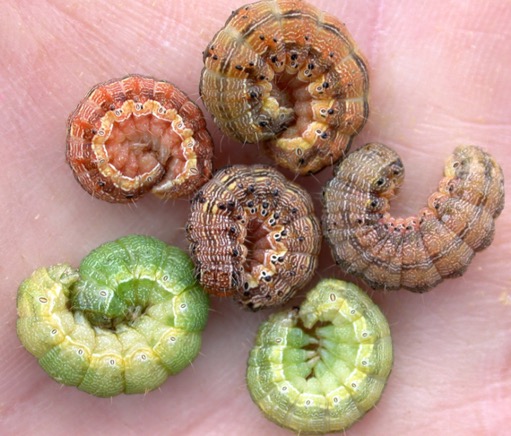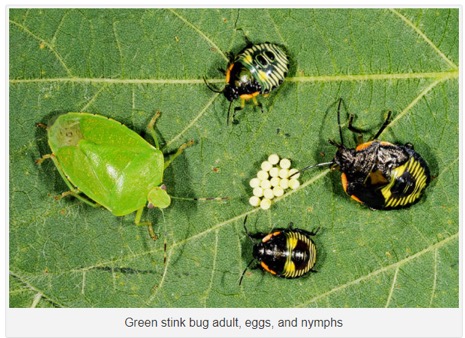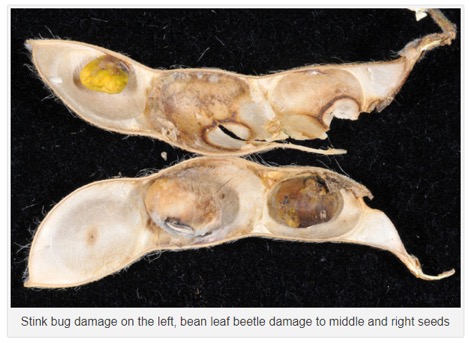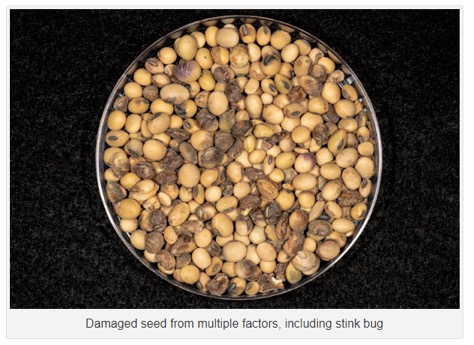Brought to you by: Jonah T. Johnson, MS, CPAg, CCA - Sales Agronomist, PCT | Sunrise
September 9, 2019: Watch out for late-season insect damage in corn and soybeans!
Corn and soybean growth stages varies across Ohio from seed-fill to some areas are harvesting both crops. A few insects of relevancy currently are stink bug in soybeans and corn earworm in corn.
Corn Earworm
Corn earworm, rather unusually, has been frequently seen across Ohio this year in field corn and especially high levels in sweetcorn fields. Corn earworm is a pest with many hosts including corn, tomatoes and certain legumes. In Ohio it is typically considered a pest of sweet corn rather than field corn, but this past week substantial populations have been found in certain field corn sites. Corn earworm moths are most attracted to fields in the early green silk stage as a place to lay their eggs. These eggs hatch into the caterpillars that cause ear-feeding damage, open the ear to molds, and attract birds. With a wide range of planting dates this year, different fields may be at greater risk at different times.
It is open to debate how well corn earworm can overwinter in most parts of Ohio, and the majority of our population probably immigrates each summer from more southern states. Weather fronts from the south can help carry influxes of moths our way. Compounding the problem, many of these southern moths are resistant to some of the Bt hybrids used against them in the past.
They vary quite a bit in color – with individuals that are dark brown, brown, tan, green, or even pink in color.

The Bt protein Vip3A (in Viptera) is still deemed effective against corn earworm. For a current infestation in field corn, because chemical control is ineffective, the scouting emphasis should be on assessing mold and disease levels in infested corn. When corn earworm moths are immigrating, sweet corn growers often rely on frequent insecticide sprays to kill adult moths, which is not economical in field corn.

Feeding sites or exit holes when the caterpillar matures and leaves the ear leave holes in the corn husk, which provide a potential entry wound for pathogens like fusarium and gibberella. Some of these organisms can then be a further source for mycotoxins, including fumonisins and deoxynivalenol, also known as vomitoxin. In some cases, damaged kernels will likely be colonized by opportunistic molds, meaning that the mold-causing fungi are just there because they gain easy access to the grain. However, in other cases, damaged ears may be colonized by fungi such as fusarium, gibberella and aspergillus that produce harmful mycotoxins. Some molds that are associated with mycotoxins are easy to detect based on the color of the damaged areas. For instance, reddish or pinkish molds are often cause by gibberella zeae, a fungus know to be associated with several toxins, including vomitoxin.
So, since it is not always easy to tell which mold is associated with which fungus or which fungus produces mycotoxins, the safe thing to do is to avoid feeding moldy grain to livestock. Mycotoxins are harmful to animals – some animals are more sensitive to vomitoxin while others are more sensitive to fumonisins, but it is quite possible for multiple toxins to be present in those damaged ears. If you have damaged ears and moldy grain, get it tested for mycotoxins before feeding to livestock, and if you absolutely have to use moldy grain, make sure it does not make up more than the recommended limit for the toxin detected and the animal being fed.
Stinkbug
In 2018, multiple species of stinkbug (green, brown and marmorated) caused severe seed quality issues on soybeans. Overall, insect feeding has been low for Ohio field crops in 2019, but green stink bugs are being seen in many late-season, seed filling staged fields. Both green stink bug adults and nymphs feed using their piercing-sucking mouthparts. They cause injury to soybean by puncturing pods and sucking fluid from the developing beans. This feeding also introduces bacteria, fungi and yeasts that may cause further damage. Seeds that do develop despite stink bug pod feeding may be smaller, shriveled, and/or discolored. This damage may lower quality, and ultimately reduce yields. Green stink bugs may appear in soybean fields from mid-July through harvest time.




Resources:
- The Ohio State University Extension C.O.R.N. newsletter: https://agcrops.osu.edu/newsletter/corn-newsletter/2019-27/corn-earworm-field-corn-watch-molds
- Purdue University Pest & Crop Newsletter: https://extension.entm.purdue.edu/newsletters/pestandcrop/article/green-stink-bug-worth-a-look-in-seed-filling-soybean-fields/